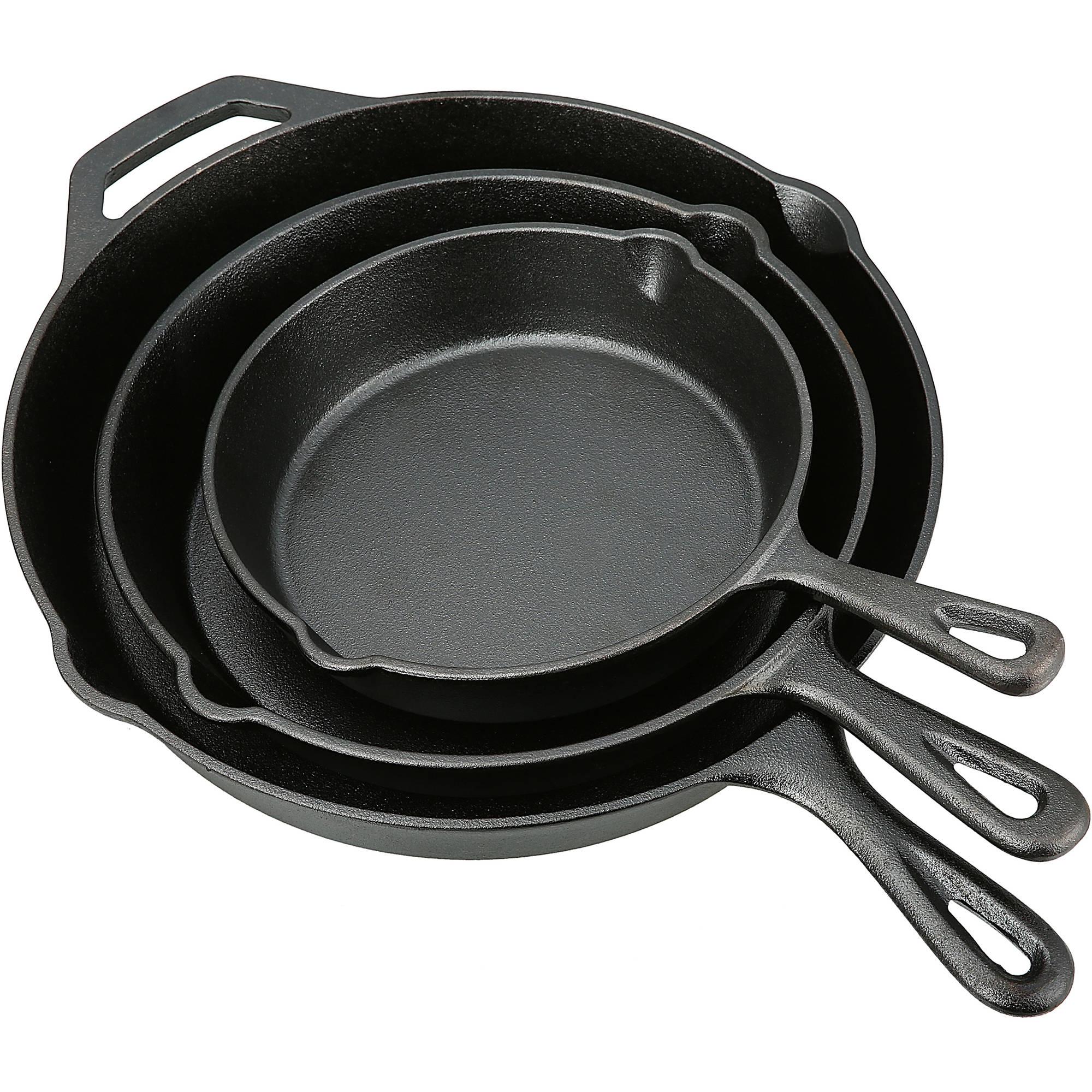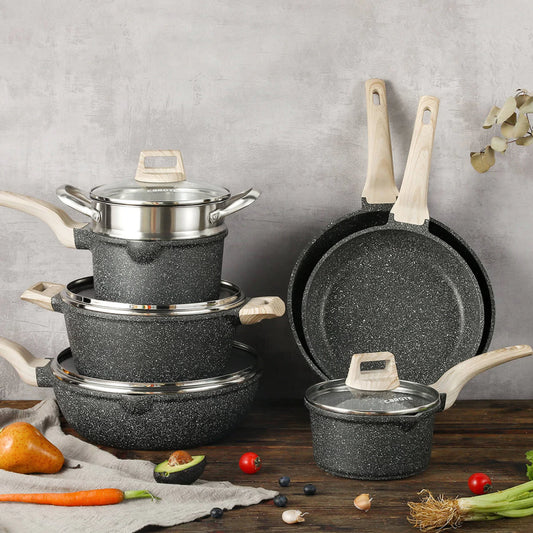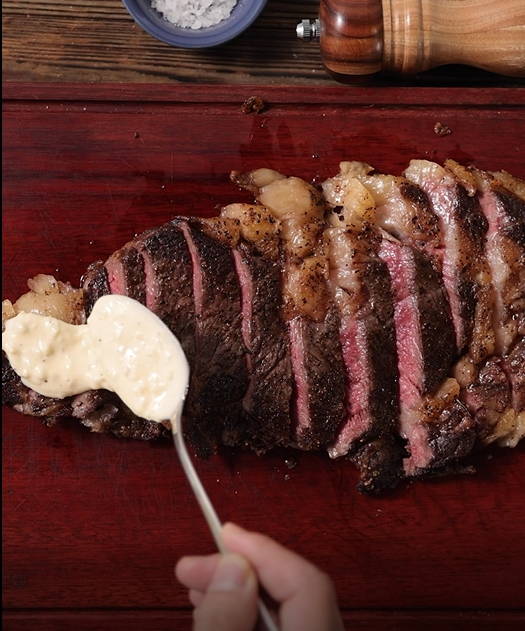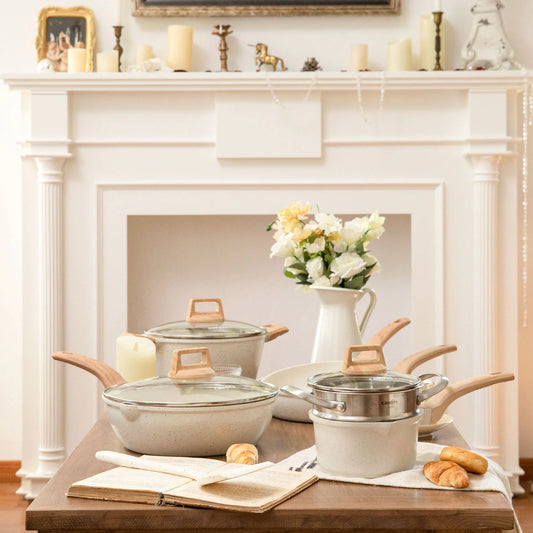Wonder what cookware do you need? Don't know where to start? There is an endless variety of pots and pans to cook with. However, you can make a much more educated decision about which cookware to use when preparing your everyday breakfast, lunch or dinner.
Here's a list of 5 Essential Pots and Pans for Beginner:
With a 10-to-12-inch nonstick skillet, you'll need less fat and spend less time cleaning up. You can use it to sauté meat, grill an omelette and fry some vegetables. It's easy to maintain as well. To protect the coating, do not use metal utensils or wash them in the dishwasher. Just soak and clean with a soft cloth and dishwashing liquid
Maybe you might be concerned about nonstick cookware being coated with toxic chemicals. However, these days, most manufacturers have to go through severe testing and standards, so you don't have to worry about anything harmful being coated on your cookware that will seep into your food.
2) Cast Iron Skillet

The cast-iron skillet has been a standard in American and European kitchens for hundreds of years. It conducts and retains heat well and for a long time. That's why it's fantastic for going from stovetop to oven to your dining table, and it keeps your food warm throughout the entire meal! Before storing your cookware, remember to wipe the skillet with a few drops of oil to keep the surface seasoned and to help develop that characteristic nonstick coating of well-used cast iron.
Besides, always clean the skillet gently with water and a plastic scrubber. Never scrub with metal pads, and never put soap into a cast-iron skillet because it can penetrate the coating and it will affect the flavour of the food you cook later. Look for a skillet with a spout for pouring off fat if you think you'll use it for frying.
3) Enameled Cast Iron Dutch Oven
This attractive, all-around stew pot is ideal for braising, slow cooking, steaming, and deep-frying. Unlike traditional cast iron, this pot has an enameled finish over the interior and exterior of the pot. Besides, it has a thick bottom and sides, with a snug, tight-fitting lid that traps in moisture and flavour. The sides and bottom must be thick to retain and evenly distribute heat and prevent hot spots. Therefore, it is built for both oven and stovetop use and has outstanding heat retention.
Great care should be taken when cleaning your enamel Dutch oven with baking soda. Firstly, in a small bowl, mix baking soda with water to form a thick paste. Apply the paste with a soft sponge and rub in a circular motion until the stains are removed. Next, add some water and dishwashing liquid to remove excess paste. Once the food stains disappear, rinse the pan with water and dry thoroughly.
4) Stockpot

A stockpot is usually large, both length and width. This 8-to-10-quart stockpot is for cooking in large quantities because it holds enough water to boil up to 2 pounds of pasta, so you don't have to cook your pasta in batches when feeding a crowd. Whenever you need to cook soup, stew, vegetables in bulk, sauce for pasta or pasta itself, you should be picking up the stockpot.
With its delicate nature, it's important to clean it gently. Therefore, try to clean it with minimal scrubbing by using only vinegar and lemon instead. Pour vinegar into the pot, slice the lemon into 4 or more pieces and bring this to a boil. Let it simmer for 30 minutes, and the charred food will lift right off. Next, gently scrub the pot with a soft sponge and remove the remaining stubborn pieces. Lastly, rinse it clean and let it dry.
5) Saucepan
This traditional 3-to-4-quart saucepan has tall, straight sides that prevent moisture loss, which is what you need when steaming, blanching, making sauce or soup. It is also a smaller version of the stockpot or from the same branch, giving a round shape. The walls are as thick as the bottom for better heat distribution.
The sides of the saucepan are tall enough to make it deep cookware for the liquid food to boil and develop the best taste. It comes with a lid so you can put it up and do your other chores while it cooks on its own. An important task often designated to saucepans is boiling water for a small serving of pasta. It's also a good choice for mashed potatoes, risotto, lentils, or any other grain requiring boiling.







